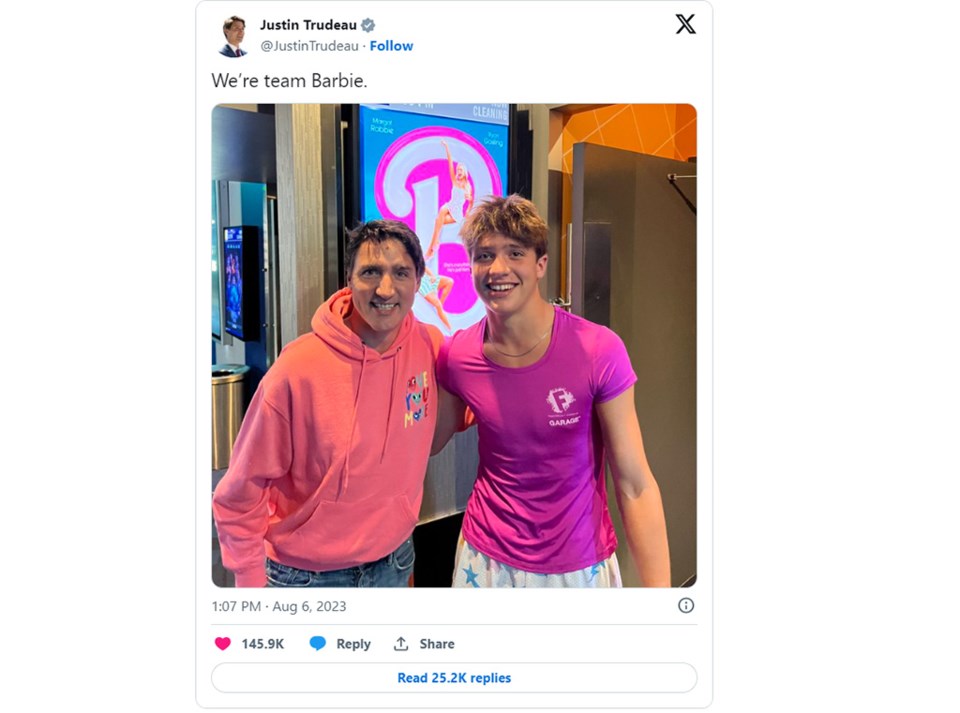THE CONVERSATION — Barbie is this summer’s hit movie, breaking all kinds of records at the box office. Many, including myself and family — as well as Canada’s prime minister and son — dressed in pink to watch a team of live-action Barbies confront the patriarchy.
The film has caused a media storm, even before . Much of the conversation about Barbie zoned in on men and masculinity.
First, the frequent use of the word patriarchy by the Barbies in the film upset some commentators. They claim the film is
Conservative British journalist with a tweet saying “so glad I’m not Canadian” (to which many Canadians responded, “we’re glad too”).
Get news that’s free, independent and based on evidence.
Of course, others argue in its critique of the patriarchy.
If you have not seen the film, Barbie and Ken live in a woman-centered (plastic) world until they accidentally find the real world. Once there, they have to confront the reality of patriarchy. Ken (played by Ryan Gosling), finds the “real world” empowering. He became “super cool” donning a big fur coat, showing off his rippling muscles and abs and adding ubiquitous horse motifs to his home.
The strong independent Barbies, however, suddenly find themselves in subservient roles.
Meanwhile, Allan, Ken’s best friend (played by Michael Cera), remains his helpful, quiet self. Although , he is clearly an audience favourite. Requests for the Allan doll and many have .
Ken, in the end, learns he doesn’t need to be the macho man and he is “Kenough” as he is. That is, he is OK with leaving the patriarchy behind.
Can men in the real world follow Ken’s lead? Can we stop trying to prove we are manly men, and instead be “Kenough?” Can we aspire to be more like Ken’s best friend, Allan — a more suitable ally to women?
And crucially: How do we know if we are more like Ken or Allan?
What does allyship look like?
Although not exactly the same, this concept of how to be more like Allan — or an “ally to women” — was basically the topic of my most recent collaborative study. My research focuses on white men’s allyship looking at anti-racism, anti-colonization and gender justice.
I spent the past five years working with the and the to look at white men’s allyship.
I worked with a group of diverse study advisers. Together, they
The study included the wisdom and guidance of community leader’s expectations of allyship and also white men who shared their experiences of what it was like to try to become an ally.
Those white men aiming to achieve allyship shared their starting points and experiences. They all spoke about struggling with the expectations of being a man.
Some also spoke about being bullied and not wanting anyone to experience that kind of pain. Those that had been bullies in the past talked about experiencing intense regrets.
Many of the men identified a turning point that changed their lives and put them on a path toward allyship. For some, it was learning about patriarchy in university. For others, it was hearing the stories of people who faced oppression and marginalization that challenged their view of the world as a meritocracy. In this way, they began to make commitments to human rights and social justice.
For all of them, the work they did was helped along by women, who took the time and energy to mentor them.
If you are struggling with whether you are a Ken or an Allan, here are five questions to ask yourself.
Are you a Ken or an Allan?
1) How do I act with the group I want to ally with?
How and why are you joining a group? What kinds of things should I be doing in the group? How can I be open to learning from critique and feedback?
For example, in the Barbie movie, Allan shared why he was motivated to help Barbie. Allan helped the Barbie’s plans, but he didn’t come in and take over.
Also, accept that you will inevitably say the wrong thing. Just learn from it and keep showing up when it gets uncomfortable.
2) How do I act with other allies?
Refrain from being competitive with other allies. Instead, create safe groups to support each other and share what you are learning.
3) How do I act within organizations of power?
Do you defend them? Do you simply think about making them more “diverse-friendly,” or do you listen to women and marginalized people and support what they are doing? For example, what should Allan do when Mattel offers him the position of Executive VP of Barbie Inclusion?
4) How do I act in my relationships with people who are not committed to justice and challenging the patriarchy?
Building relationships takes time. Everyone needs some space to learn and grow. Can you put in the work to help Ken’s become “Kenough?”
5) Can I be accountable for changing how I behave?
What is your relationship to your masculinity? Like Ken at the end of the movie, can you become “Kenough” and be open to what women have to say? Can you critique masculinity, and what it means for injustice in the world? Can you support the goal of equality?
If you’re a man, you can do all this while looking cool. Just do the work, don’t be a jerk. Strive to become “Kenough,” or an Allan, and follow Barbie, women and others who are marginalized in the fight to overthrow patriarchy.
is a post-doctoral associate at the University of Calgary. Halvorsen receives funding from MITACS and the Social Sciences and Humanities Research Council. Halvorsen is also an active member of the Alberta Men's Network and consultant with the Alberta Network of Immigrant Women.
You can no longer count on social media to deliver important news to you. Keep your news a touch away by bookmarking SASKTODAY.ca's homepage at this link.
Here's why you should bookmark your favourites.



